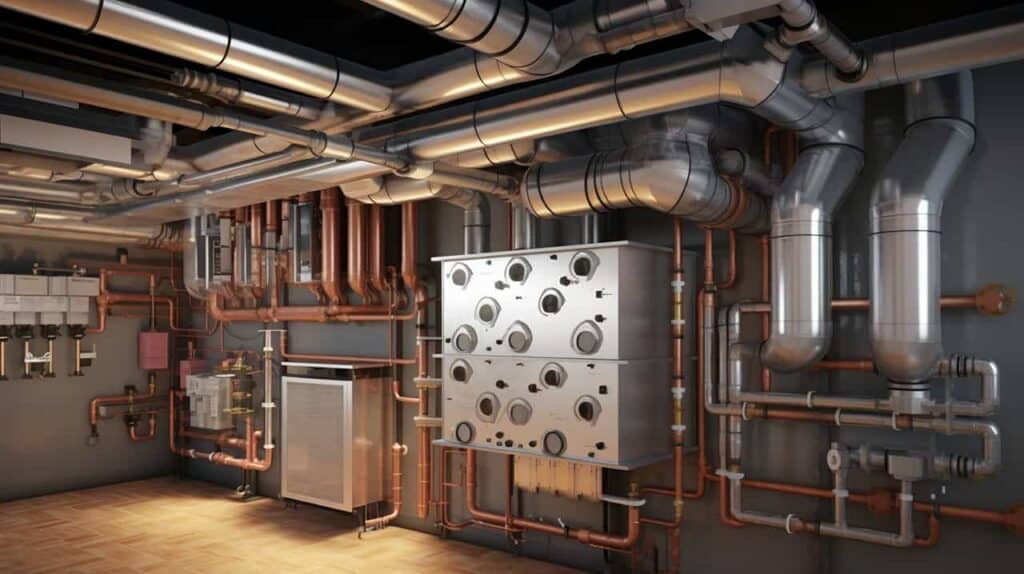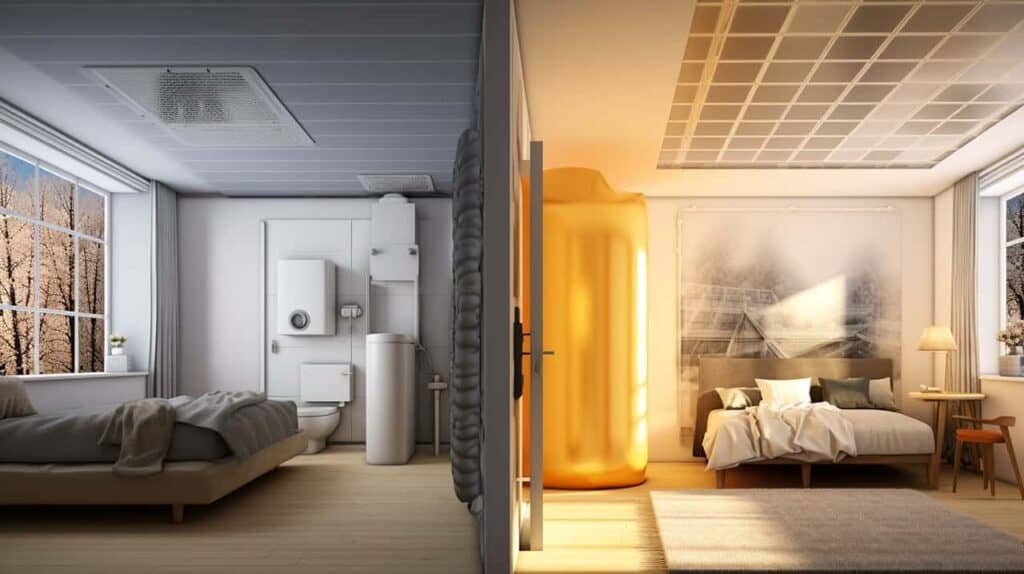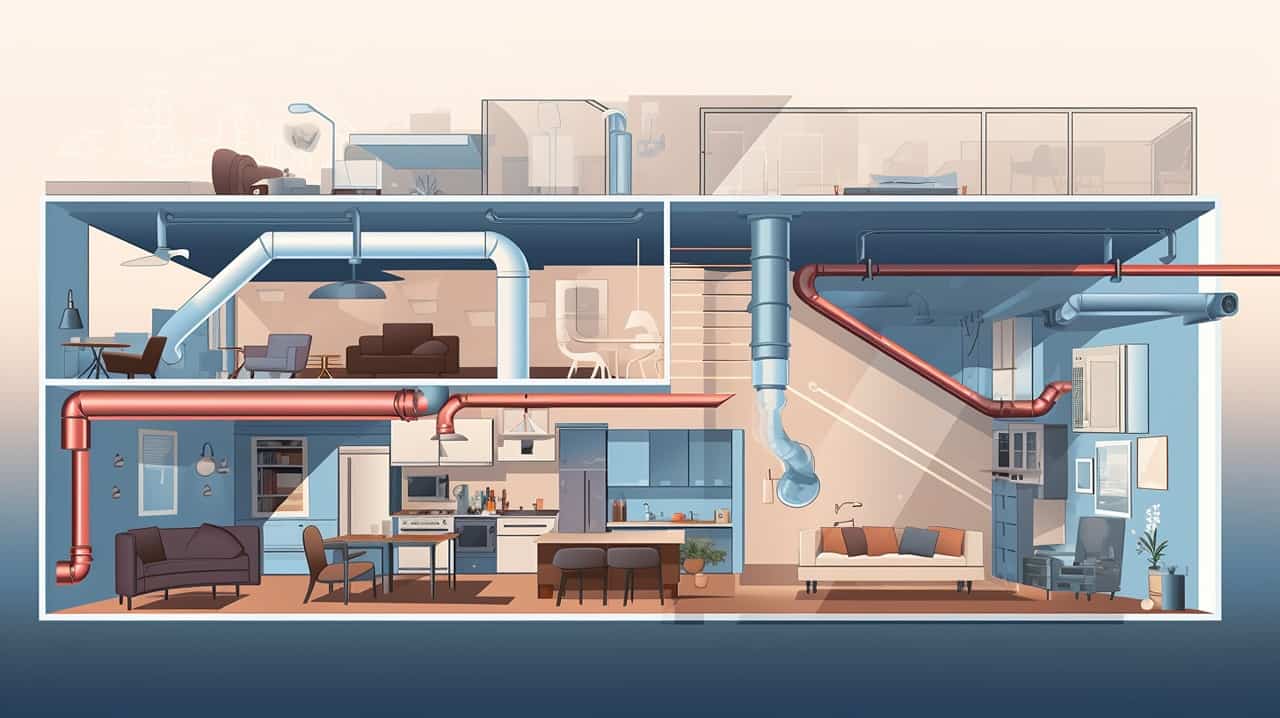As a homeowner, I understand the importance of having a well-designed and efficient ductwork system in my home.
But you might be wondering, why is ductwork design so crucial? Well, let me tell you. Poorly designed ductwork can lead to temperature inconsistencies and significant energy loss.
That’s why it’s essential to carefully consider factors like location, sealing, insulation, air distribution, and sizing before installing or upgrading your ductwork.
In this article, I’ll guide you through the key aspects to consider, ensuring optimal performance and energy efficiency for your home.
Key Takeaways
Proper ductwork design is crucial for efficient air distribution and balanced temperatures throughout the home.
Aging ductwork can result in reduced airflow, leaks, and energy loss, requiring regular maintenance and inspection.
Efficient ductwork design includes considerations such as the location of ducts, sealing and insulation, and proper air distribution.
Maintaining efficient ductwork involves minimizing air leaks, maintaining balanced airflow, designing ductwork for each room, and considering professional inspection and maintenance.
Table of Contents
Cost Considerations

When considering ductwork, it’s important to take into account the cost of materials and installation. HVAC ductwork installation cost can vary depending on several factors, such as the size of the space, the type of ductwork chosen, and the complexity of the installation.
One common material used for ductwork is fiberglass. Fiberglass ducts are known for their durability and insulation properties, making them a popular choice in many HVAC systems. The cost of fiberglass ductwork installation can range from $5 to $10 per linear foot, including both materials and labor. However, it’s important to note that this cost may vary depending on the specific requirements of the project.
It’s advisable to consult with a professional contractor to accurately estimate the cost of fiberglass ductwork installation for your specific needs. By considering the cost of materials and installation, you can make informed decisions about your ductwork project and ensure that it aligns with your budget.
Compatibility With Existing HVAC System

In my experience, it’s important to ensure that the new ductwork design is compatible with my existing HVAC system. When considering a new ductwork design, it’s crucial to take into account the specifications and requirements of the existing HVAC system. This compatibility is essential for optimal performance and efficiency.
The first step is to assess the capacity and size of the HVAC system. The new ductwork design should be able to accommodate the airflow and ventilation needs of the system. It’s important to check if the existing HVAC system can handle the changes in the ductwork layout and configuration.
Additionally, compatibility also involves considering the type of ductwork used. There are various types of ductwork, such as sheet metal, flexible, or fiberglass. It’s important to choose a ductwork material that’s compatible with the existing HVAC system and meets the system’s requirements for air distribution and pressure.
Furthermore, the new ductwork design should align with the energy efficiency goals of the existing HVAC system. It should be designed to minimize air leakage and maximize airflow efficiency. This ensures that the system operates at its optimum level and reduces energy consumption.
Energy Efficiency Implications

Based on my experience, ensuring compatibility between the new ductwork design and the existing HVAC system is crucial for achieving energy efficiency goals. When planning for ductwork installation or upgrades, it’s important to consider the following:
- Assess the existing HVAC system: Before designing the new ductwork, it’s essential to evaluate the capabilities and limitations of the current HVAC system. This will help determine if any modifications or upgrades are needed to ensure optimal compatibility and efficiency.
- Size and capacity: The size and capacity of the new ductwork should be carefully calculated to match the requirements of the HVAC system. Oversized or undersized ducts can lead to inefficient airflow and energy waste.
- Air distribution and balancing: Proper air distribution is key to achieving energy efficiency. The new ductwork design should ensure balanced airflow throughout the space, avoiding zones with inadequate heating or cooling.
By considering these factors and designing the ductwork accordingly, you can ensure that your HVAC system operates efficiently, reducing energy consumption and enhancing comfort in your living space.
It’s always advisable to consult with a professional to ensure the compatibility and efficiency of your ductwork design.
Noise Levels and Soundproofing Options

From my experience, I’ve found that addressing noise levels and exploring soundproofing options can greatly enhance the comfort and tranquility of a living space. Noise pollution can disrupt our daily lives and create a sense of unease. By taking measures to reduce noise, we can create a more peaceful environment where we can relax and focus.
One effective way to reduce noise is through soundproofing. Soundproofing involves adding materials or implementing design strategies to minimize the transmission of sound. There are various options available for soundproofing, depending on the specific needs and budget of the individual.
Here is a table outlining some common soundproofing options:
| Option | Description | Benefits |
|---|---|---|
| Acoustic Panels | Absorb sound waves and reduce echo in a room | Improves clarity of audio and reduces noise reverberation |
| Soundproof Curtains | Block external noise and reduce sound transmission | Easy to install and provide a temporary solution |
| Insulation | Enhance the soundproofing capabilities of walls and floors | Reduces airborne noise and vibrations |
| Double Glazed Windows | Provide an additional layer of insulation against noise | Reduces outside noise and improves energy efficiency |
| Door Seals and Gaskets | Prevent sound leakage around doors and windows | Creates a tighter seal, reducing noise infiltration |
Potential Impact on Indoor Air Quality
Addressing the potential impact on indoor air quality is crucial for maintaining a healthy and comfortable living environment. When it comes to ductwork, there are several factors to consider that can affect the quality of the air we breathe. Here are three key points to keep in mind:
- Proper filtration: Choosing the right air filters for your HVAC system is essential in removing airborne particles and allergens from the air. High-efficiency filters can trap even the smallest particles, improving indoor air quality and reducing the risk of respiratory problems.
- Regular maintenance: Keeping up with regular maintenance, such as cleaning and inspecting your ductwork, can prevent the accumulation of dust, mold, and other contaminants. This helps to ensure that the air circulating in your home remains clean and healthy.
- Ventilation: Adequate ventilation is crucial for removing stale air and introducing fresh air into your living space. Properly designed ductwork can help facilitate proper ventilation, preventing the buildup of harmful pollutants and maintaining good indoor air quality.
Frequently Asked Questions
How Long Does Ductwork Typically Last Before It Needs to Be Replaced?
Ductwork typically lasts around 15-20 years before replacement is needed. Regular maintenance and inspections can extend its lifespan. Hiring a professional ensures quality service and helps identify any inefficiencies in your system.
Can Ductwork Be Installed in a Home That Doesn’t Have an Existing HVAC System?
Yes, ductwork can be installed in a home without an existing HVAC system. It requires careful planning to determine the best layout and design for optimal air distribution and efficiency.
Are There Any Government Incentives or Rebates Available for Upgrading or Installing New Ductwork?
There may be government incentives or rebates available for upgrading or installing new ductwork. It’s worth researching and consulting with professionals to explore potential savings and benefits.
Can Ductwork Be Installed in a Way That Minimizes Noise Levels and Provides Soundproofing Options?
Ductwork can be installed to minimize noise and provide soundproofing options. Proper insulation, sealing, and choosing the right materials can help reduce noise levels and create a quieter indoor environment.
Does the Type of Ductwork Material Used Have Any Impact on Indoor Air Quality?
The type of ductwork material used can impact indoor air quality. Certain materials, like fiberglass, can release particles into the air, while others, like metal, are less likely to do so.
Conclusion
In conclusion, when it comes to ductwork, proper design and installation are essential for optimal performance and energy efficiency.
One interesting statistic to consider is that poor ductwork design can result in up to 20% energy loss. This not only impacts utility costs but also affects the comfort and air quality in your home.
By carefully considering factors such as location, sealing, insulation, air distribution, and sizing, homeowners can ensure balanced air distribution, reduced energy consumption, and a comfortable living environment.

